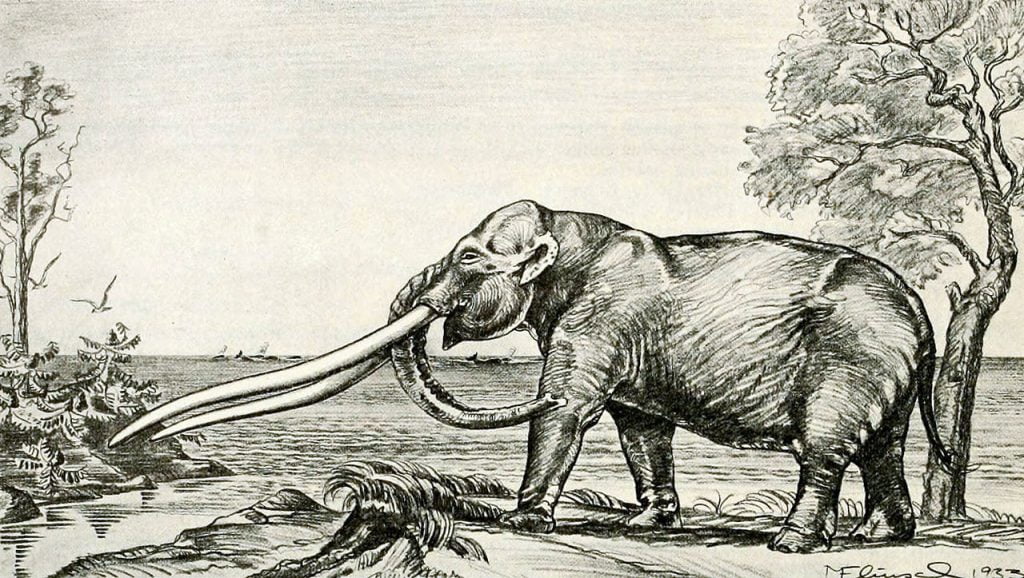Anancus (Pike-Tusked Elephant)

Although not as famous, Anancus was at least as big as its cousins the mammoths.
Originally Posted by Shade of the En World forums.
This elephantine creature has extremely long, straight tusks, almost as long as its body, jutting straight out from its mouth. Its ears and trunk are smaller than most other elephants.
The anancus is a proboscidean adapted to life in temperate forests, where it feeds on foliage. Its size and deadly tusks prevent most predators from bother it, although its young sometimes fall prey to larger carnivores.
An anancus has a shoulder height of about 15 feet, weighs between 8 and 10 tons, and has tusks roughly 15 feet long.
| Anancus (Pike-Tusked Elephant) | |
| Huge animal | |
| Hit Dice | 10d8+60 (105 hp) |
| Initiative | +0 |
| Speed | 40 ft. (8 squares) |
| Armor Class | 16 (-2 size, +8 natural), touch 8, flat-footed 16 |
| Base Attack/Grapple | +7/+27 |
| Attack | Gore +17 melee (2d10+18) |
| Full Attack | Slam +17 melee (2d6+12) and 2 stamps +15 melee (2d6+6) or gore +17 melee (2d10+18) |
| Space/Reach | 15 ft./10 ft. (15 ft. with tusks) |
| Special Attacks | Improved grab, toss, trample 2d8+18 |
| Special Qualities | Low-Light Vision, Scent |
| Saves | Fort +13, Ref +7, Will +4 |
| Abilities | Strength 34, Dexterity 10, Constitution 23, Intelligence 2, Wisdom 12, Charisma 7 |
| Skills | Listen +10, Spot +9 |
| Feats | Alertness, Improved Bull Rush, Multiattack, Power Attack |
| Environment | Temperate forest |
| Organization | Solitary or herd (2-20) |
| Challenge Rating | 8 |
| Treasure | None |
| Alignment | Always neutral |
| Advancement | 11-20 HD (Huge); 21-28 HD (Gargantuan) |
| Level Adjustment | – |
COMBAT
An anancus usually only becomes aggressive if it or its young are threatened. Once angered, it attacks with its long tusks, scooping up smaller foes and tossing them against trees or onto the ground to be trampled.
Improved Grab (Ex): To use this ability, an anancus must hit a Large or smaller opponent with a gore attack. If it gets a hold, it tosses its opponent.
Jungle Movement (Ex): Pike-tusked elephants have supreme agility and maneuverability despite their size, allowing them to pass through the thickest forests with ease. An anancus can move through light undergrowth without penalty, and treats heavy undergrowth as light undergrowth for the purposes of movement (two squares to pass through, +2 to Tumble and Move Silently DCs).
Narrow Berth (Ex): Due to its narrow body, an anancus is treated as being one size smaller than it actually is for the purposes of squeezing (see page 149 of the Player’s Handbook for the rules for squeezing).
Toss (Ex): Pike-tusked elephants vigorously shake any creature caught in their tusks and fling it in a random direction. Resolve the toss as a bull rush maneuver (+20 check modifier), except that there is no attack of opportunity, since the anancus has already grabbed its foe when it tries to toss the victim. The anancus does not need to move with its foe in order to to throw its foe more than 5 feet. If the tossed victim beats the anancus’s bull rush check, he remains in his current square with no ill effects and is not grappled any longer. Tossed victims take impact damage on landing as if they had fallen a distance equal to the distance they were tossed.
Trample (Ex): As a full-round action, an anancus can move up to twice its speed and literally run over Large or smaller creatures. This attack deals 2d8+18 points of damage. Trampled opponents can make attacks of opportunity against the anancus at a -4 penalty. If they do not make attacks of opportunity, trample opponents can attempt a DC 27 Reflex save for half damage. The save DC is Strength-based.
Originally appeared in Dragon Magazine #167 (1991).

 Buy me a coffee
Buy me a coffee